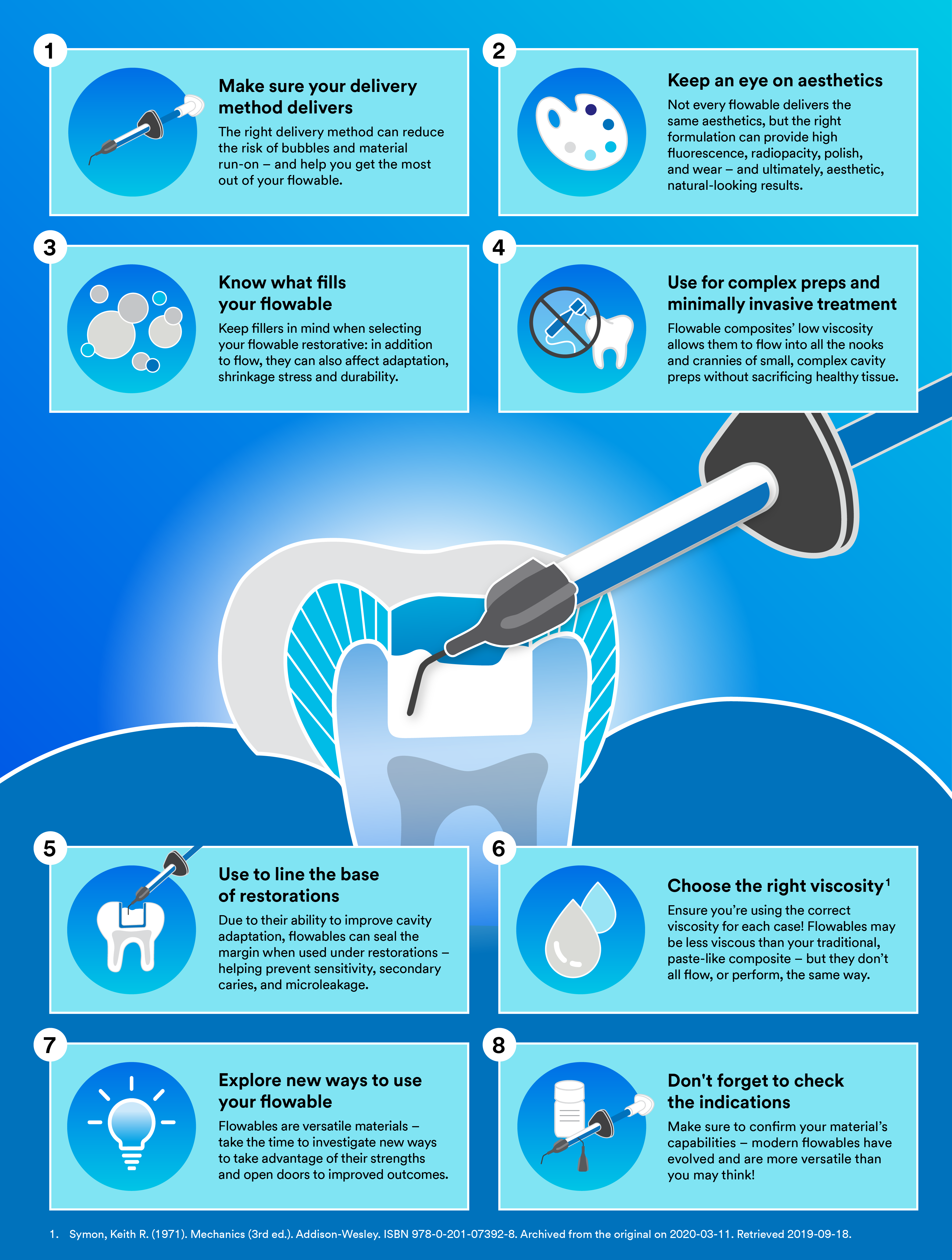
‘Flowables’ are more than just fluid dental composite – they are incredibly versatile materials that present many restorative opportunities. Here is a list of tips to help you get the most out of your flowable composites.
How to go with the flow when doing a composite restoration
1. Make sure your delivery method delivers
One of the biggest complaints that clinicians have about flowables are the bubbles that appear during dispensing. These tiny voids can be hard to see and difficult to get rid of once in the prep and can cause:
- Staining
- Optical defects
- Microleakage
- Limits to the lifetime of the restoration.
There are ways to reduce bubbles, including re-etching, vertical storage, or incremental placement and filling of voids with additional composite. But each requires additional, time-consuming steps.
A better solution may be a different delivery method. The innovative syringe designed for 3M Filtek Supreme Flowable Restorative and 3M Filtek Bulk Fill Flowable Restorative are engineered to eliminate bubbles and run-on, while improving handling. The new bendable cannula, now available in three diameters, provides better access in those hard-to-reach places for easier injecting.
When your material and delivery method work together like this, it can bring you closer to a bubble-free restoration.
2. Keep an eye on aesthetics
In addition to durability, the ideal flowable composite should provide aesthetic, natural-looking results. But there are many factors that go into matching natural dentition, including:
- Colour
- Translucency
- Fluorescence
- Radiopacity
- Polish retention.
And not every flowable brings the same level of aesthetics to the table.
While flowables are available in many shades, they’re often more translucent, less radiopaque, and less fluorescent than their universal counterparts, due to their lower filler content. This limits their usefulness in certain situations (Baroudi and Rodrigues, 2015). However, 3M’s nanotechnology enables refined properties at the nanoscale – resulting in versatile flowables with:
- High fluorescence
- Radiopacity
- Polish
- Improved wear rivaling that of some universal composite materials.
3. Know what fills your flowable composites
First-generation flowables owed their low viscosity to lower filler content. However, reducing filler content can impact physical, mechanical, and especially wear properties. This trade-off is why many clinicians still distrust flowables in load-bearing areas.
But flowables have evolved dramatically. Newer materials use different filler particle sizes, shapes and concentrations to improve mechanical properties while maintaining desirable flow characteristics. For example, Filtek Supreme Flowable Restorative features nano-sized filler particles that provide:
- Excellent wear resistance
- Strength
- Polish retention
- Optical properties, and
- Reduced polymerisation shrinkage.
Keep fillers in mind when selecting your restorative. In addition to flow, they can also affect adaptation, shrinkage stress and durability.
4. Use for complex preps and minimally invasive treatment
As the demand for minimally invasive treatment increases, clinicians are seeking new methods that preserve healthy oral tissue. Flowables lend themselves to this philosophy. Their low viscosity allows them to flow into all the nooks and crannies of small, complex cavity preps without sacrificing healthy tissue. By making use of flowables, you can open a door to a new avenue of treatment.
5. Use as a liner for the base of restorations
Because flowables have demonstrated improved cavity adaptation, they’re often used under restorations to seal the margin – helping prevent sensitivity and secondary caries. In fact, studies have shown that using a flowable as a liner can result in less microleakage regardless of whether a conventional or nanofilled composite is used (Margolis, 2011).
Resin modified glass ionomers (RMGIs) are a solid alternative to flowable composites – both can be used successfully to line a restoration.
6. Choose the right viscosity (Simon, 1971)
Flowable composites are defined by their low viscosity, which can provide:
- Easier flow
- More rapid filling
- Improved syringe delivery, and
- Better cavity adaptation.
You can count on flowables to be less viscous than your traditional, paste-like dental composite – but they don’t all flow, or perform, the same way.
Different clinical situations can require different viscosities of flowable composite. It’s not enough to simply select the most fluid option. If your viscosity is too low, it can translate to:
- More shrinkage stress
- Reduced mechanical and physical properties
- Run-on or slumping.
Make sure you’re using the correct viscosity for your case. For example, some materials flow well during extrusion and thicken within the cavity prep, while others self-level. Filtek Bulk Fill Flowable Restorative uses unique chemistry to lower viscosity without increasing polymerisation shrinkage (Baroudi and Mahmoud, 2015).
7. Explore new ways to use your flowable composites
Flowables are recommended for many indications – including some you may not expect. Take the time to investigate new ways you can take advantage of their strengths and open doors to improved outcomes.
Consider:
- Bonding orthodontic brackets and retainers
- Bonding attachments in aligner treatment
- Abfraction lesions and erosive lesions
- Repair of small defects.
Flowables are versatile materials. In addition to improving flow, they can also help streamline your procedures. They’re a valuable tool for your practice – especially if you know your material well enough to take advantage of everything it has to offer.
8. Don’t forget to check the indications
From core build-ups to pit and fissure sealants, flowables have been recommended for many indications – but not all. On the flip side, many dental professionals underutilise flowables based on the limitations of early generation products.
Modern flowables have come a long way, and may be more versatile than you think. So always double-check your material’s capabilities before choosing – or writing off – a flowable composite.
Flowable solutions from 3M:
For aesthetics, choose 3M Filtek Supreme Flowable Restorative.
- Excellent adaptation, polish retention and wear resistance
- Features 3M’s TRUE nanotechnology
- Class III and V restorations
- Features syringe design that virtually eliminates bubbles and material ‘run-on’.
For efficiency, use 3M Filtek Bulk Fill Flowable Restorative.
- Excellent adaptation, low shrinkage
- Ideal as a liner, bulk fill base, sealant and more
- Base under Class I and II direct restorations
- Features syringe design that virtually eliminates bubbles and material ‘run-on’.











